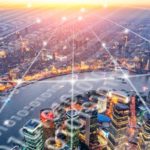Technological Innovations: Which ones will come on line during 2018?
The technological revolution has the intensity of a tsunami. What’s new today will be old tomorrow, and will give way to new disruptive phenomena. What’s the next step?

Experts in technological innovation have outlined a roadmap for 2018, full of advances in areas that have already been explored this year. And, according to Gonzalo León, head of the Technological Innovation Support Center (CAIT) of Universidad Politécnica de Madrid, this means "maturity".
The digital mesh
In its forecasts for 2018 report, U.S. tech-specialist consultancy Gartner says that the world will be interwoven over a huge intelligent digital mesh that will allow people, devices, content and services to interact.
Scientist and programmer Andrew Ng’s words at Stanford’s Graduate School of Business: still resonate: “[Artificial Intelligence] is the biggest revolution the world has seen since electricity first became widespread one hundred years ago: I can’t think of one single industry that won’t be transformed by it in the mid-term.”
As the technology develops, Artificial Intelligence (AI) and machine learning will start finding their way into a growing range of devices, from smart medical equipment to crop harvesting robots.
According to Paul Daugherty, Head of Technology and Innovation at the consulting firm Accenture, at the corporate level AI will be the “face of the digital brand of tomorrow’s enterprise.” He says AI is set to become a “key competency that will require investment and a strategic approach from the top management.”
Healthcare Wearables
Artificial Intelligence will also contribute to improving our health. “We’ll see many implementations, not so much at pharma level, but rather at wearable level, with advanced monitoring and quick diagnosis solutions," says Arístides Senra, head of Innovation, Commercialization and Business Creation at Universidad Politécnica de Madrid (UPM).

The use of healthcare wearable devices will grow during 2018.
The monitoring prowess of these new technologies will not be limited to our bodily signs. According to IBM’s 5 in 5 report, “new cognitive systems capable of analyzing and identifying patterns in the way we talk and write will enable doctors and patients to predict and track early-stage developmental disorders, mental illness and degenerative neurological diseases more effectively.”
Facebook is already developing predictive models to prevent suicide, while Cogito, a company funded by the Massachusetts Institute of Technology (MIT), is testing an app capable of rendering an image of users’ mental health just by listening to the sound of their voice throughout the day.
An IoT of integrated solutions
The century of hyperconnectivity has just started. With the advent of 5G networks, the so-called Internet of Things will finally come to fruition, according to Gartner projections.
And, although according to CAIT's Gonzalo León, although not all organizations need an IoT, “they will become increasingly common.” In his opinion, in 2018 we will see more integrated and non-partitioned solutions, capable of offering services more “linked to the user and affordable". In other words, it won’t be so much about ‘connected things’ but what we do with these connected objects and the data they generate.
Three of the top trends of 2018 will have to do with the IoT: the data-analytics revolution, advanced computing and 5G, according to Accenture’s Paul Daugherty.
Senra, of Universidad Politécnica de Madrid (UPM), also recalls that there is still a lot to do with the “gold” of this new era: “We’ll see a lot of big data and many technologies for processing huge volumes of information.”
For Áureo Díaz-Carrasco, Chairman of the Spanish Federation of Technology Hubs (Fedit), the IoT will be pivotal in 2018. “Anything that has something to do with sensors (...) will experience a very positive leap next year.” In his opinion, this progress will be driven not just by “by business efforts, but also by the government’s economic support.”
Digital twins, ‘edge computing’ and virtual experience
Next year, we’ll see new developments in digital twin prototypes. A digital twin is a virtual model of physical assets, processes and systems. Thanks to these digital replicas of products or spaces, it will be possible to analyze and monitor systems to prevent problems, avoid down times, develop new opportunities and even plan for the future through simulations.
We’ll also see growth in edge computing, or the transversal cloud, where information processing and the gathering and delivery of content is decentralized to occur at the source of the data. Edge computing adoption trends will be driven by the increasing use of mobile devices, especially the consumption of video, virtual and augmented reality, as well as the massive deployment of sensors as part of the IoT. Analysts expect a dramatic surge in demand in 2018, although it is still not clear what the supporting infrastructure will look like.

5G networks will be decisive for IoT development.
For example, Intel estimates that driverless cars, equipped with hundreds of sensors, generate 40 terabytes of data every eight hours of driving. Transferring these huge datasets to the cloud is insecure, unnecessary and impractical. If self-driving cars were required to upload all this information to make decisions while on the streets, the results would be catastrophic. A car of these characteristics needs closer sources such as the ones enabled by edge computing. For example, if a child pops out of nowhere chasing a ball, this technology, close to the source of data, will always allow the car to react more quickly.
The virtual and augmented reality market has a lot to offer in this field. Companies will start the coming year examining specific real-life scenarios where these technologies could be applied to increase employee productivity, by streamlining the design and visualization of processes.
Ecosystems and platforms
According to Accenture, the ecosystem economy is poised to make significant progress in 2018. "companies increasingly integrate their core business functionalities with third parties and their platforms,” Accenture says, in its latest report on innovation. “As they do, they’re designing future value chains that will transform their businesses, products, and even the market itself,” says Adán Plaza, Director of Accenture Technology.
Spain will continue spearheading technological development in the agri-food processing industry, and will also make significant progress in energy efficiency and sustainability, says Áureo Díaz-Carrasco of the Spanish Federation of Technology Hubs. According to this organization, the road to a cleaner and more sustainable as “one of the strong points of 2018:”
Senra also thinks 2018 will bring many technologies related to sustainability and ‘smart cities’. “I’m not talking so much about IoT and communication, but rather about technology to improve waste management and self-consumption, which will continue to depend on local regulations," he says. “Finally,” he concludes “we will see logistics solutions for the foreseeable explosion in electronic trade, which,” he concludes,” will also bring shipping inefficiencies.”
For Díaz-Carrasco, the only trends that matter are those that society prioritizes, and society will start trusting and requesting more and more ‘blockchain’-enabled solutions. Beyond cryptocurrencies, distributed ledger technologies offer alternatives to current centralized transaction and record-keeping mechanisms that could be useful for building a business infrastructure both for digital companies and citizens.
Lastly, all these advances will have a direct impact on security. Although the basic technology has improved, Gonzalo León sees that people are having a hard time understanding data protection levels. In 2018 we will need to improve cybersecurity systems. “There is a general issue that affects all the information stored on cloud systems,” says the head of the UPM’s Technological Innovation Support Center. “It is relatively easy to hack an agricultural operation and disrupt its irrigation system, and we are not paying enough attention to devices, which are quite vulnerable,” says León, who also calls for regulatory upgrades. He says regulations will determine how much Spain progresses in technological innovation.